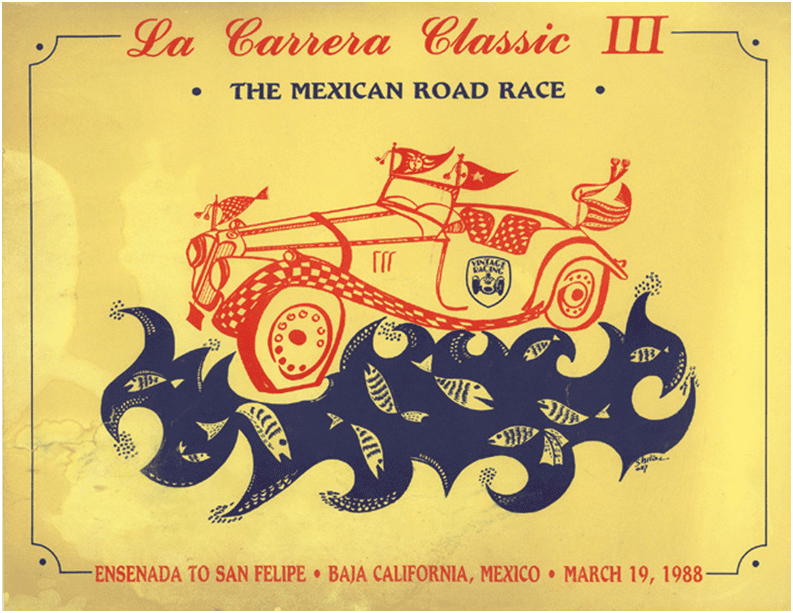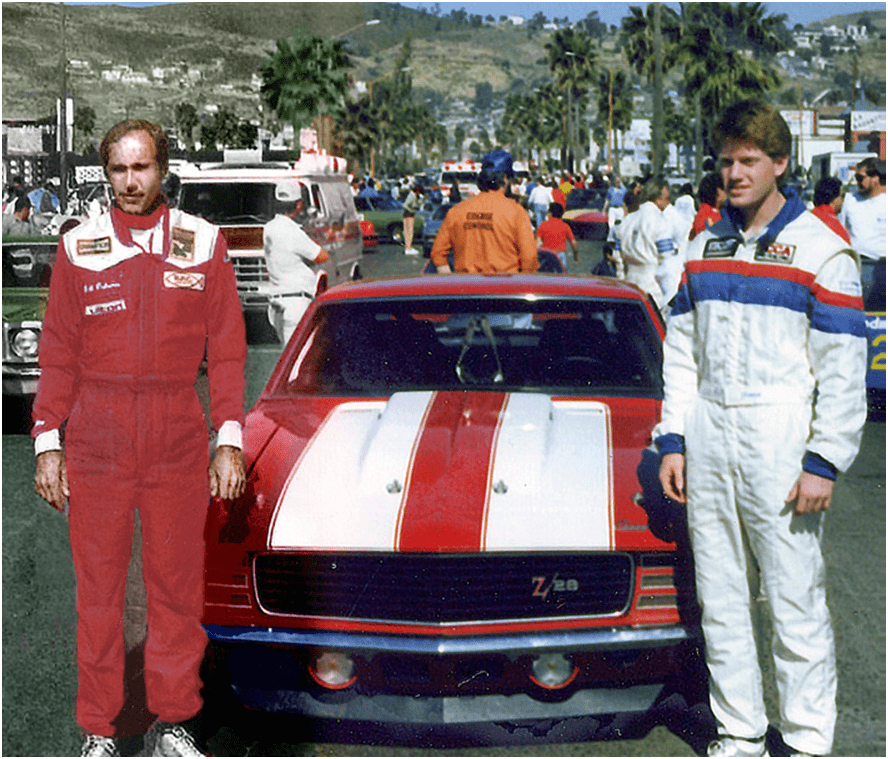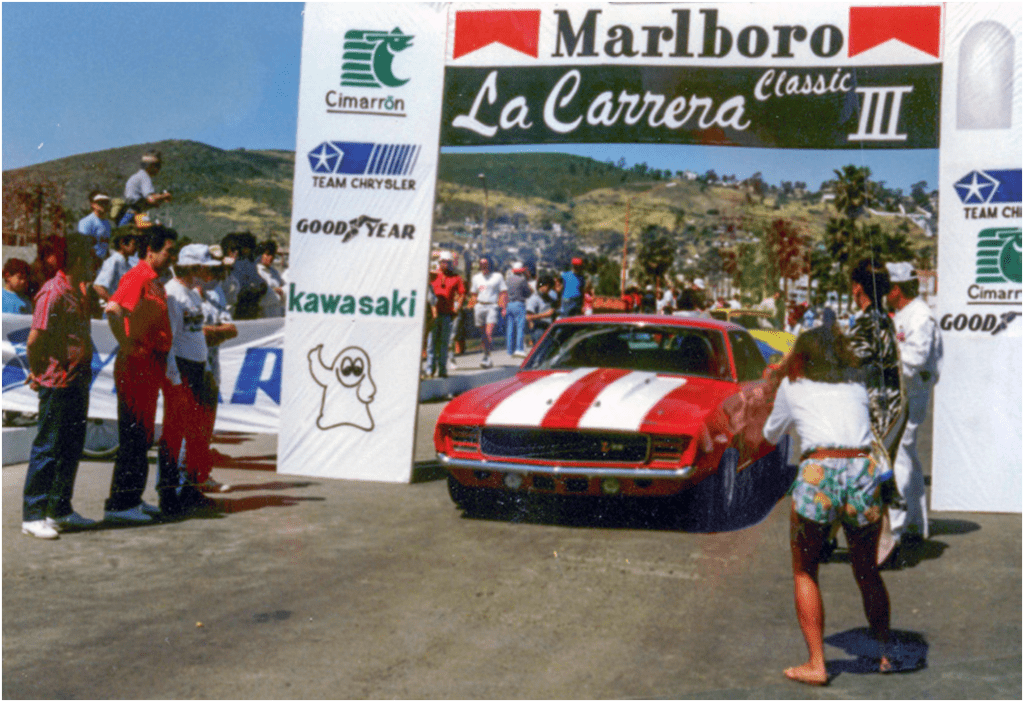Big Red History 1988

The La Carrera Classica was calling again. They’d learned their lesson, and to say that RJ was ready is really underselling it. He was determined to hit the road from Ensenada to San Felipe and chew up every single mile of it. On the surface, Big Red didn’t look that much different from the car that had taken that rock wall so brutally the year before. The racers remembered the wreck (they always do) and thought, “There’s that kid in the Camaro again.” But it wasn’t the same car; not at all. Bill Osborne had been busy in his shop. He’d built a monster of a car, its name was Big Red and its prey was every other car in attendance. With Osborne behind the wheel for the first half of the race, RJ was riding co-pilot in the garish new Camaro. They were second off the line —three minutes behind a Porsche, but gaining quickly when Bill had a mishap a mere 10 miles into the race. In a curvy section at 80 mph, Osborne lost the rear of the car and backed it into the rocky hillside. It was just a light tap, and the drivers were unhurt. With the fuel cell still intact, the damage was mostly cosmetic, so Bill righted the car and blasted back into the fray and onto the mandatory pit stop/refuel halfway through the race. Here, RJ, now thoroughly worked up, jumped behind the wheel and proceeded to destroy the second half of the course. They covered the
123-mile course at an average of 122.9 mph and a top speed at over 200 mph. Despite the early incident, Big Red won not only a decisive victory, but slated a record time as well.Big Red had blown a hole in the world of racing, and the press was taking notice. Autoweek mentioned RJ’s performance in its April 11th issue; this was Big Red’s first appearance in the motoring press, followed by a Car Craft article in August for its coverage of the race. However impressive, these were just mentions, and it takes more than that to make a legend. With Pro-Street cars all over the magazine covers at the time, Car Craft ran a full feature on Big Red in its October issue. The story was a hit with an entire generation of young gearheads who loved the idea of a fearless 18-year-old kid scorching a Mexican Highway in his ’69 Camaro. Although the term “Pro-Touring” or “G-Machine” wouldn’t be adopted for almost another decade, nearly every muscle car enthusiast will tell you that Big Red — driven by a regular guy that easily could have been one of them — started the Pro-Touring movement that’s still going strong today.Dan Gottlieb thought the La Carrera Classica series was so much fun, they ought to have one in the United States. The man got on the phone and, together with Cliff Jones, Steve .


Waldman, Roger Ward, and a few others, they organized the Silver State Classic Challenge (SSCC) in Nevada, a race that is still being run today The venue was safer—brutally fast, yes—but safer. Emergency medical attention would be closer, and course closure was easier to control along the 92-mile run on Nevada Highway 318 from Lund to Hiko, both of these points were always a concern in Mexico. Probably the least talked about reason for Dan wanting to organize an event like La Carrera in the U.S. was that there had already been grumblings while south of the border by other competitors about this Camaro and how it wasn’t really a production car anymore. So, the first SSCC was organized quickly, and while Big Red was ready, RJ, still in high school, couldn’t make it. So Dan got behind the wheel of his modified Corvette. He wasn’t really expecting much, but ended up taking second place in the inaugural event, averaging 158 mph. Jim Liautaud, Jr., took first place in his Ferrari Testarossa — smoking the track at an average of 162.58 mph.

The La Carrera Classica was calling again. They’d learned their lesson, and to say that RJ was ready is really underselling it. He was determined to hit the road from Ensenada to San Felipe and chew up every single mile of it. On the surface, Big Red didn’t look that much different from the car that had taken that rock wall so brutally the year before. The racers remembered the wreck (they always do) and thought, “There’s that kid in the Camaro again.” But it wasn’t the same car; not at all.
Bill Osborne had been busy in his shop. He’d built a monster of a car, its name was Big Red and its prey was every other car in attendance. With Osborne behind the wheel for the first half of the race, RJ was riding co-pilot in the garish new Camaro. They were second off the line —three minutes behind a Porsche, but gaining quickly when Bill had a mishap a mere 10 miles into the race. In a curvy section at 80 mph, Osborne lost the rear of the car and backed it into the rocky hillside. It was just a light tap, and the drivers were unhurt. With the fuel cell still intact, the damage was mostly cosmetic, so Bill righted the car and blasted back into the fray and onto the mandatory pit stop/refuel halfway through the race. Here, RJ, now thoroughly worked up, jumped behind the wheel and proceeded to destroy the second half of the course. They covered the 123-mile course at an average of 122.9 mph and a top speed at over 200 mph. Despite the early incident, Big Red won not only a decisive victory, but slated a record time as well.
Big Red had blown a hole in the world of racing, and the press was taking notice. Autoweek mentioned RJ’s performance in its April 11th issue; this was Big Red’s first appearance in the motoring press, followed by a Car Craft article in August for its coverage of the race. However impressive, these were just mentions, and it takes more than that to make a legend. With Pro-Street cars all over the magazine covers at the time, Car Craft ran a full feature on Big Red in its October issue. The story was a hit with an entire generation of young gearheads who loved the idea of a fearless 18-year-old kid scorching a Mexican Highway in his ’69 Camaro.

Although the term “Pro-Touring” or “G-Machine” wouldn’t be adopted for almost another decade, nearly every muscle car enthusiast will tell you that Big Red — driven by a regular guy that easily could have been one of them — started the Pro-Touring movement that’s still going strong today.



The venue was safer—brutally fast, yes—but safer. Emergency medical attention would be closer, and course closure was easier to control along the 92-mile run on Nevada Highway 318 from Lund to Hiko, both of these points were always a concern in Mexico. Probably the least talked about reason for Dan wanting to organize an event like La Carrera in the U.S. was that there had already been grumblings while south of the border by other competitors about this Camaro and how it wasn’t really a production car anymore. So, the first SSCC was organized quickly, and while Big Red was ready, RJ, still in high school, couldn’t make it. So Dan got behind the wheel of his modified Corvette. He wasn’t really expecting much, but ended up taking second place in the inaugural event, averaging 158 mph. Jim Liautaud, Jr., took first place in his Ferrari Testarossa — smoking the track at an average of 162.58 mph.

-
Early Racing Adventures
-
La Carrera Classica I
-
Big Crash as La Carrera II
-
Triumph at La Carrera III
-
Dominatation at La Carrera IV
-
Victory again at Silver State
-
Victory at Nevada Open
-
International Acclaim
-
Reviving the Legend
-
Big Red in Fast & Furious
-
205 mph at Texas Mile
-
210 mph at Mojave Mile
-
Victory at Silver State
-
234 mph at Mojave Magnum
-
227 mph at Bonneville
-
Cover of Hot Rod Magazine
-
238 mph at Mojave Mile
-
Big Red 100% rebuilt
-
Devastating Fire
-
252 mph at Texas Mile
-
259 mph at Bonneville
-
256 mph Harvest 1.5 Mile
-
251 mph at Spaceport Half Mile
-
249 mph Arkansas Mile
-
Domination at Big Bore Bash
-
Domination at TX2K Street Racing
-
Upcoming Races & Events